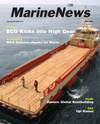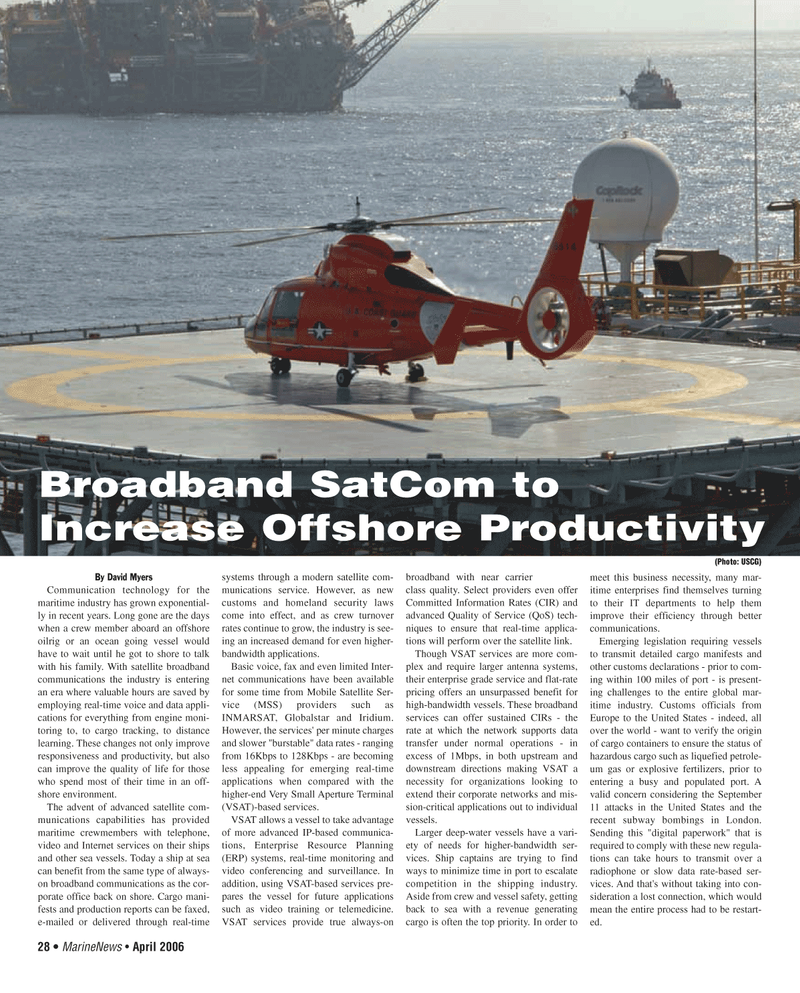
Page 28: of Marine News Magazine (April 2006)
Offshore Support
Read this page in Pdf, Flash or Html5 edition of April 2006 Marine News Magazine
By David Myers
Communication technology for the maritime industry has grown exponential- ly in recent years. Long gone are the days when a crew member aboard an offshore oilrig or an ocean going vessel would have to wait until he got to shore to talk with his family. With satellite broadband communications the industry is entering an era where valuable hours are saved by employing real-time voice and data appli- cations for everything from engine moni- toring to, to cargo tracking, to distance learning. These changes not only improve responsiveness and productivity, but also can improve the quality of life for those who spend most of their time in an off- shore environment.
The advent of advanced satellite com- munications capabilities has provided maritime crewmembers with telephone, video and Internet services on their ships and other sea vessels. Today a ship at sea can benefit from the same type of always- on broadband communications as the cor- porate office back on shore. Cargo mani- fests and production reports can be faxed, e-mailed or delivered through real-time systems through a modern satellite com- munications service. However, as new customs and homeland security laws come into effect, and as crew turnover rates continue to grow, the industry is see- ing an increased demand for even higher- bandwidth applications.
Basic voice, fax and even limited Inter- net communications have been available for some time from Mobile Satellite Ser- vice (MSS) providers such as
INMARSAT, Globalstar and Iridium.
However, the services' per minute charges and slower "burstable" data rates - ranging from 16Kbps to 128Kbps - are becoming less appealing for emerging real-time applications when compared with the higher-end Very Small Aperture Terminal (VSAT)-based services.
VSAT allows a vessel to take advantage of more advanced IP-based communica- tions, Enterprise Resource Planning (ERP) systems, real-time monitoring and video conferencing and surveillance. In addition, using VSAT-based services pre- pares the vessel for future applications such as video training or telemedicine.
VSAT services provide true always-on broadband with near carrier class quality. Select providers even offer
Committed Information Rates (CIR) and advanced Quality of Service (QoS) tech- niques to ensure that real-time applica- tions will perform over the satellite link.
Though VSAT services are more com- plex and require larger antenna systems, their enterprise grade service and flat-rate pricing offers an unsurpassed benefit for high-bandwidth vessels. These broadband services can offer sustained CIRs - the rate at which the network supports data transfer under normal operations - in excess of 1Mbps, in both upstream and downstream directions making VSAT a necessity for organizations looking to extend their corporate networks and mis- sion-critical applications out to individual vessels.
Larger deep-water vessels have a vari- ety of needs for higher-bandwidth ser- vices. Ship captains are trying to find ways to minimize time in port to escalate competition in the shipping industry.
Aside from crew and vessel safety, getting back to sea with a revenue generating cargo is often the top priority. In order to meet this business necessity, many mar- itime enterprises find themselves turning to their IT departments to help them improve their efficiency through better communications.
Emerging legislation requiring vessels to transmit detailed cargo manifests and other customs declarations - prior to com- ing within 100 miles of port - is present- ing challenges to the entire global mar- itime industry. Customs officials from
Europe to the United States - indeed, all over the world - want to verify the origin of cargo containers to ensure the status of hazardous cargo such as liquefied petrole- um gas or explosive fertilizers, prior to entering a busy and populated port. A valid concern considering the September 11 attacks in the United States and the recent subway bombings in London.
Sending this "digital paperwork" that is required to comply with these new regula- tions can take hours to transmit over a radiophone or slow data rate-based ser- vices. And that's without taking into con- sideration a lost connection, which would mean the entire process had to be restart- ed. 28 • MarineNews • April 2006
Broadband SatCom to
Increase Offshore Productivity (Photo: USCG)
APRIL MN2006 4(25-32).qxd 4/7/2006 3:11 PM Page 28

 27
27

 29
29
